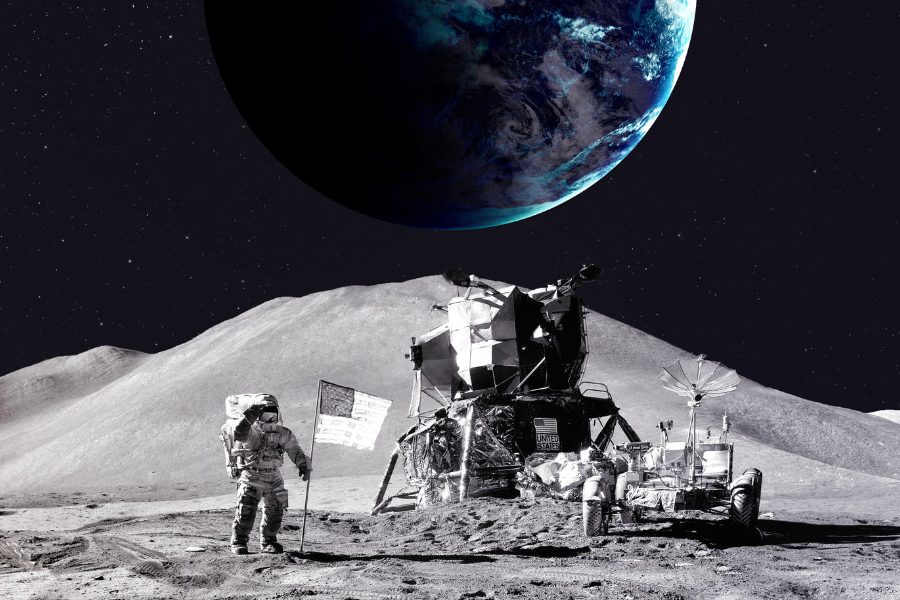What does it mean to race into space? During the middle decades of the 1900s, the United States and the Soviet Union engaged in competitive technological sprints. They were racing to achieve key spacefaring milestones that would mark national power and prestige. Dive deeper to understand more comprehensively what is the Space Race!
Lasting roughly from 1955 to 1975, this frontier quest drove rapid advances in rocketry while captivating the world with otherworldly possibilities. But what exactly catalyzed this clash of superpowers beyond Earth’s atmosphere, and what was at stake during the race to the Moon?
While captivating global mindshare with possibilities, this race would take a more intense geopolitical turn, with national agendas shaping competitive trajectories. The Space Race emerged from early advances in rocket technology during WWII and converted to develop missiles able to strike long-distance targets.
In this article, we retrace the origins, major milestones, and legacy of this frontier quest called the Space Race era, we’ll revisit key launchpad moments from Sputnik’s beeps to the planetary photo Earthrise that helped shape modern views of spaceship Earth.

What Is the Space Race?
So, what is the Space Race about? The Space Race refers to the intense competition between the United States and the Soviet Union during the Cold War era to achieve significant milestones in space exploration.
It began with the launch of the Soviet satellite Sputnik 1 in 1957, marking the first artificial satellite in orbit. The rivalry reached a pinnacle with the 1969 Apollo 11 mission when the United States successfully landed the first humans, Neil Armstrong and Buzz Aldrin, on the Moon.
The Space Race encompassed a series of groundbreaking achievements, technological advancements, and geopolitical strategies as both superpowers sought to demonstrate their prowess and capabilities in space exploration.
Origins of the Space Race
Post-WWII tensions
The origins of the Space Race trace back to escalating technological capabilities in rocketry and a mounting ideological rivalry between the United States and the Soviet Union after WWII.
Both superpowers sought to project power and technological superiority by developing sophisticated missile programs capable of delivering nuclear warheads across continents. Spacefaring milestones also offered skillful propaganda contrasts between competing political systems.
Sputnik shock
When the Soviets successfully launched Sputnik 1 in 1957 as the first artificial satellite in space, it signaled a perception that Russian engineering had surpassed its US counterpart.
The world’s first orbital satellite brought concerns that if the Soviets could loft satellites overhead, they could also direct long-range ballistic missiles to remote targets.
Competition for cosmic firsts
This surprising Soviet lead helped fan both public fears and government determination to aggressively regain technological ground. The race was on to achieve significant space exploration feats through competing “firsts” between the rival states.
Visionary goals like sending astronauts into orbit, photographing the Moon’s farside, or landing a man on the Moon pushed the boundaries of human achievement. This intense competition between nations, fueled by both military ambitions and the rapid growth of peaceful satellites, unfolded against a backdrop of missile arsenals targeting Earth and sky filled with satellites.
Sputnik 1 – Dawn of the Space Age
The Space Age began in earnest with the Soviet Union’s stunning launch of Sputnik 1 on October 4, 1957. This polished metal sphere with a trailing antenna transmitted radio signals detectable around the world as it orbited Earth at 18,000 mph and altitudes up to 588 miles.
Lasting 92 days in space, Sputnik 1 awed as the first artificial satellite while escalating US-Soviet technological tensions.
Beyond kickstarting the Space Race, Sputnik 1 also altered global perceptions about access to space within reach. Its name means “satellite” or “fellow traveler” in Russian; the small beeping orb ushered growing excitement but also anxieties about threats from overhead.
It signified the dawning possibilities of satellites facilitating worldwide communication, surveillance, and science.

The Race to the Moon Begins
The early Space Race saw Soviet milestones like Yuri Gagarin achieving the first human spaceflight in 1961, increasing pressure on the US to definitively respond. When Alan Shepard became the first American in space, it signaled earnest determination even as his suborbital arc fell short of Gagarin’s Earth orbit.
President Kennedy significantly raised the stakes in 1962 by directly challenging NASA to successfully send astronauts to the moon and back safely before the decade closed. This bold proclamation launched the intensive technological mission acceleration needed for Project Apollo’s constitution.
As Space Race tensions mounted through the 1960s, NASA consistently tested rocket power while developing capsules, navigation, computing, and life support systems reliable enough for the daunting lunar voyage.
Parallel Soviet efforts sought to robotically sample the Moon first until a disastrous launch failure temporarily grounded their N-1 program. With mission-proven equipment and procedures, NASA astronauts would race for global prestige as the decade closed.
The Apollo Program – America’s Lunar Triumph
The Apollo program represented the US response to the Space Race through a direct national project goal proposed by President Kennedy to land astronauts on the Moon and return them safely by the end of the 1960s.
Meeting this timeline required intensive technology development by NASA and aerospace partners, creating the most complex vehicles ever engineered for spaceflight.
Teams across America assembled new launch vehicles like the enormous Saturn V and sophisticated space capsule systems to support humans voyaging a quarter million miles into deep space.
Astronauts trained rigorously on Earth while engineers contended with solving daunting challenges like reliable life support, computer guidance, orbital maneuvers, and Moon landings.
On July 20, 1969, 650 million viewers watched global live feeds as the Apollo 11 crew touched down on the lunar Sea of Tranquility. There Neil Armstrong uttered humanity’s first alien words from the surface while colleague Buzz Aldrin joined him outside as millions experienced vicarious thrills from this peaceful celestial triumph.
Technological Innovations
The Space Race spawned major developments in rocketry, aviation, computing, and satellite technologies. Advances included lightweight alloys, freeze-dried foods and solid-state miniaturized electronics tested under extreme conditions. Military applications arose from heat-resistant tiles to digital flight controls to freeze-proof gear.
On the scientific front, innovations included executing the first planetary gravitational assists and extended spacewalks while presaging permanent habitats in orbit.
Monitoring Earth itself from space fed realizations about the planet’s profound atmospherical, geological, and ecological interconnections – the legacy “Earthrise” image presented a unifying vision for this water planet sailing through the void.
Space Race Legacy – Beyond the Moon
Technological innovation legacy
While the Apollo lunar landings marked the Space Race’s symbolic endpoint and a NASA focus on low-Earth shuttles followed in the 1970s, the rivalry indelibly accelerated technological innovation across the interconnected domains of science, aviation, and defense.
Advances in computing, telemetry, propulsion materials, and remote imaging paved the way for new generations of spacecraft and global satellite networks. The pioneering orbital science platforms launched during the initial Space Race tensions evolved by the 1980s-90s.
They evolved into steadfast cooperation on versatile space stations continuously inhabited for decades – from Russia’s Mir to today’s International Space Station jointly assembled in orbit.
Global spacefaring today
Multiple space agencies now pool knowledge and resources to achieve more in deep space exploration, from Mars rovers to comet landers and interplanetary probes surveying outer giant planets and their intriguing moons.
Legacy launch vehicles originally developed for nuclear tensions now convey international crews and experiment payloads on cooperative missions into Earth orbit and beyond. At the same time, a rising private space industry re-envisions new entrepreneurial potential across the inner solar system.

Lessons Learned – Cooperation in Space
From rivalry to collaboration
The Space Race emerged within an atmosphere of rivalry and proxy technological conflicts across Earth. However, the shared ambition to explore space, its demands for substantial resources, and the scientific realities of physics without national bias gradually overcame ideological divisions over ensuing generations.
As the benefits and wonders of space science and exploration touched more lives worldwide, the coalition and community trended toward replacing competition as missions embraced international cooperation.
Orbital diplomacy
The International Space Station stands as a paragon of unity across 15 nations and five parallel space agencies. This permanently inhabited orbital science complex simply could not have formed amidst the contentious nationalist context back in the 1969 timeframe of Apollo 11.
The maturation of space exploration beyond flags and footprints reflects hard-learned perspectives – from expanding total innovation capacity through interdependency to forging a crewed path toward eventual multiplanetary peace.
Unsung Heroes – People Behind the Space Race
Engineers and innovators
Behind emblematic figures brightly spotlighted in astronaut spacesuits stand thousands-strong teams of engineers, physicists, designers, and fabricators who coalesced the sciences and technologies enabling human access to space.
Names like Wernher von Braun, Sergei Korolev, and Katherine Johnson only begin representing the vast dedicated networks of individuals behind the Space Race.
These networks solved many dilemmas, from orbital mechanics calculations and navigational algorithms to pioneering rocket designs and space medicine practices. They also established worldwide tracking and data relay infrastructures critical for spaceflight coordination.
Sacrifice and dedication
Early spacefaring ambitions also carry legacies of tremendous sacrifice and risk alongside grand achievement. Failed test flights were lethal for pilots and crews.
It was tough to see setbacks amidst the triumphs, but they were there. The challenges and stress that accumulated took a toll on everyone involved in advancing state space projects.
The long marches toward salient “firsts” in space gathered as mosaics of collective human dedication as much as advancing technical capability. Behind each etched milestone lies expansive supporting casts whose work enabled pioneering Space Race events to unfold.
Looking Ahead – The Future of Space Exploration
Ongoing deep space missions continue expanding human and robotic presence beyond Earth’s environs – from Chang’e lunar landers to Mars orbiters and rovers analyzing climates and geochemistry; asteroids probed and comets intercepted by flybys out to Jupiter and its ocean worlds.
Groundbreaking new generations of heavy-lift rockets like NASA’s SLS or SpaceX’s Starship aim to return astronauts to the Moon to establish permanent international outposts by mid-century as testing grounds for the first pioneer treks toward the Martian sphere in the 2030s.
During the Space Race era, it was incredible to see how visionary goals, once seen as fanciful, could actually mobilize societies in such a short period of time. With the right resources, talent, and conviction, history was made.
Tomorrow’s milestones await, ready to inspire our species’ restless cosmic migration outward for ages ahead. The new Space Race is on – no longer nation versus nation but humanity’s long-term quest to chart and inhabit ever farther frontiers.
Conclusion
The Space Race began as intense competition between nations, driven by Cold War political tensions. However, the unifying view of Earth as seen from orbiting satellites lead to greater space cooperation over time.
In addition to clarifying what is the Space Race, this article has also illuminated the core spirit that defined the dramatic mid-century quest to rapidly push boundaries – pursuing feats deemed impossible at the time through ambition, innovation, and determination.
By looking beyond nationalistic pride and short-term gains in space, we can find promise in the boundless knowledge and possibilities to uncover. If humanity perseveres with the restless curiosity that drives exploration, future generations may discover amazing things in space we cannot yet imagine.
This article aimed to spotlight that beyond nationalism or glory, the Space Race implored our shared humanity and cosmic perspectives.
